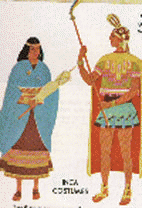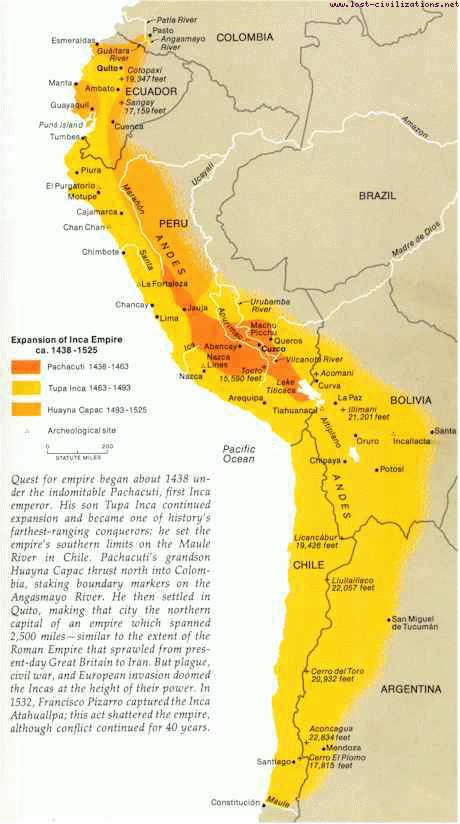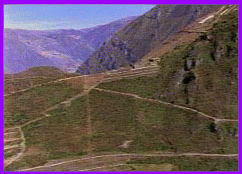Inca Civilization

Inca can be spelled Inka and was known as Tiwantinsuya.
As ancient civilizations sprang up across the planet thousands of years ago, so too the Inca civilization evolved. As with all ancient civilizations, its exact origins are unknown. Their historic record, as with all other tribes evolving on the planet at that time, would be recorded through oral tradition, stone, pottery, gold and silver jewelry, and woven in the tapestry of the people.
The Inca of Peru have long held a mystical fascination for people of the western world. Four hundred years ago the fabulous wealth in gold and silver possessed by these people was discovered, then systematically pillaged and plundered by Spanish conquistadors. The booty they carried home altered the whole European economic system. And in their wake, they left a highly developed civilization in tatters. That a single government could control many diverse tribes, many of which were secreted in the most obscure of mountain hideaways, was simply remarkable.
No one really knows where the Incas came from that historic record left in stone for archaeologists to unravel through the centuries that followed.
The Inca Empire was quite short-lived. It lasted just shy of 100 years, from ca.1438 AD, when the Inca ruler Pachacuti and his army began conquering lands surrounding the Inca heartland of Cuzco, until the coming of the Spaniards in 1532.

In 1438 the Inca set out from their base in Cuzco on a career of conquest that, during the next 50 years, brought under their control the area of present-day Peru, Bolivia, northern Argentina, Chile, and Ecuador. Within this area, the Inca established a totalitarian state that enabled the tribal ruler and a small minority of nobles to dominate the population.
Most of the accounts agree on thirteen emperors. The Inca emperors were known by various titles, including “Sapa Inca,” “Capac Apu,” and “Intip Cori.” Often, an emperor was simply referred to as The Inca.
The first seven were legendary, local, and of slight importance. During this period the Inca were a small tribe, one of many, whose domain did not extend many miles around their capital city, Cuzco. They were warriors, almost constantly at war with neighboring tribes. Ritual sacrifices were common, evidence of which is found by archaeologists to this very day.
Cusco was the center of the Inca Empire, with its advanced hydraulic engineering, agricultural techniques, marvelous architecture, textiles, ceramics and ironworks.
THE EMPORERS / KINGS
1. Manco Capac – Sun God
2. Sinchi Roca
3. Lloque Yupanqui
4. Maita Capac
5. Capac Yupanqui
6. Inca Roca
7. Yahuar Huacac
8. Inca Viracocha
9. Pachacuti-Inca-Yupanqui
10. Topa Inca Yupanqui
11. Huayna Capac
12. Huascar
13. Atahuallpa
The incredibly rapid expansion of the Inca Empire began with Viracocha’s son Pachacuti, who was one of the great conquerors, and one of the great men in the history of the Americas. With his accession in 1438 AD reliable history began, almost all the chroniclers being in practical agreement.
Pachacuti was called considered the greatest man that the aboriginal race of America has produced. He and his son Topa Inca were powerful rulers conquering many lands as they built ther kingdom.
Pachacuti was a great civic planner as well. Tradition ascribes to him the city plan of Cuzco as well as the erection of many of the massive masonry buildings that still awe visitors at this this ancient capital.
Plan of attack
The Aymara-speaking rivals in the region of Lake Titicaca, the Colla and Lupaca, were defeated first, and then the Chanca to the west. The latter attacked and nearly captured Cuzco. After that, there was little effective resistance. First the peoples to the north were subjugated as far as Quito, Ecuador, including the powerful and cultured kingdom of Chim on the northern coast of Peru. Topa Inca then took over his father’s role and turned southward, conquering all of northern Chile as far as the Maule River, the southernmost limit of the empire. His son, Huayna Capac, continued conquests in Ecuador to the Ancasmayo River, the present border between Ecuador and Colombia.
GEOGRAPHY
The Incans gave their empire the name, ‘Land of the Four Quarters’ or the Tahuantinsuyu Empire. It stretched north to south some 2,500 miles along the high mountainous Andean range from Colombia to Chile and reached west to east from the dry coastal desert called Atacama to the steamy Amazonian rain forest.
The Incas ruled the Andean Cordillera, second in height and harshness to the Himalayas. Daily life was spent at altitudes up to 15,000 feet and ritual life extended up to 22,057 feet to Llullaillaco in Chile, the highest Inca sacrificial site known today. Mountain roads and sacrificial platforms were built, which means a great amount of time was spent hauling loads of soil, rocks, and grass up to these inhospitable heights. Even with our advanced mountaineering clothing and equipment of today, it is hard for us to acclimatize and cope with the cold and dehydration experienced at the high altitudes frequented by the Inca. This ability of the sandal-clad Inca to thrive at extremely high elevations continues to perplex scientists today.
At the height of its existence the Inca Empire was the largest nation on Earth and remains the largest native state to have existed in the western hemisphere. The wealth and sophistication of the legendary Inca people lured many anthropologists and archaeologists to the Andean nations in a quest to understand the Inca’s advanced ways and what led to their ultimate demise.
ROADS

The Incas had an incredible system of roads. One road ran almost the entire length of the South American Pacific coast! Since the Incas lived in the Andes Mountains, the roads took great engineering and architectural skill to build. On the coast, the roads were not surfaced and were marked only by tree trunks The Incas paved their highland roads with flat stones and built stone walls to prevent travelers from falling off cliffs.
Referred to as an ‘all-weather highway system’, the over 14,000 miles of Inca roads were an astonishing and reliable precursor to the advent of the automobile. Communication and transport was efficient and speedy, linking the mountain peoples and lowland desert dwellers with Cuzco. Building materials and ceremonial processions traveled thousands of miles along the roads that still exist in remarkably good condition today.